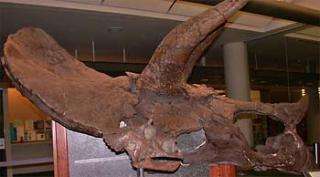An adult Triceratops skull, fully six feet long, dwarfs the foot-long skull of a year-old Triceratops (bottom center). The pair are on display in the Marion Koshland Bioscience and Natural Resources Library in the Valley Life Sciences Building. (Photos by Mark Goodwin, UC Berkeley Museum of Paleontology)
A cast of a foot-long skull from the youngest Triceratops dinosaur every discovered is now on display at the University of California-Berkeley.
Despite the pup's size, its remains are telling scientists a lot about how dinosaurs grew, the purpose of their head ornaments and the characteristics of their ancestors.
"The baby Triceratops confirmed our argument that the horns and frill of the skull likely had another function other than sexual display or competition with rivals, which people have often argued, and allows us to propose they were just as important for species recognition and visual communication in these animals," UC-Berkeley paleontologist Mark Goodwin said.
Triceratops horridus was a North American dinosaur, although ceratopsian relatives with different, but equally formidable ornamentation, roamed China and Mongolia during the Cretaceous period, 65 to 144 million years ago. Adult Triceratops could be nearly 10 feet tall and 26 feet long.
The baby's skull -- discovered by amateur fossil hunter Harley Garbani in 1997 in Montana -- is described by Goodwin in the March issue of the Journal of Vertebrate Paleontology.
Copyright 2006 by United Press International
























